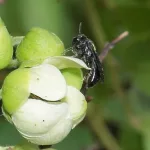A previously unknown species of bee has been identified in a conservation area on the southern slopes of Moloka‘i.
The discovery was made last in May of last year by DLNR Division of Forestry and Wildlife Survey Entomologist Dr. Karl Magnacca, during a survey with the Moloka‘i Plant Extinction Prevention Program (MoPEPP) team.
The newly identified bee species, named Hylaeus paumako — paumākō meaning “mourning” or “grief” in Hawaiian — was distinguished by its all-black face, a unique characteristic not seen in any other known male bee species on Moloka‘i.
The bees were discovered in Mākolelau, an ahupuaʻa of east Moloka‘i, which DLNR acquired in 2022 for conservation purposes. Despite significant degradation in some parts of the area from invasive species and erosion, there are pockets of native vegetation which have been fenced in. These protected areas now provide crucial habitats for native species such as Hylaeus paumako as well as many rare plants.
Hylaeus paumako is part of a diverse group of endemic bees that are native to Hawai‘i, with all 64 known species in the same genus descending from a single ancestor that arrived on the islands roughly one to 1.5 million years ago. Many have adapted to specific niches in drier and mesic (between wet and dry) forests.
New species of native insects are identified surprisingly frequently, Magnacca said he has collected some 500 new species in the past three years of field surveys.
DLNR Photo
